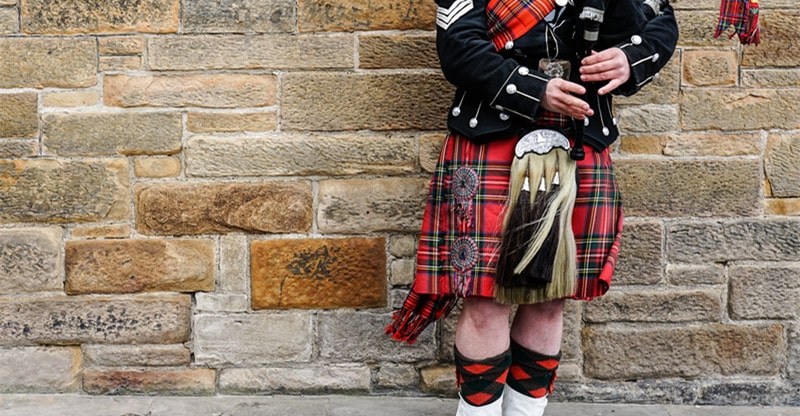The Rob Roy Tartan is one of the most popular tartans in Scotland and is also known as Old MacGregor. Rob Roy tartan is named after the Scottish outlaw, Robert Roy MacGregor, who was also known as Rob Roy. The Rob Roy Tartan is one of the tartans authorized by Queen Elizabeth II to be worn in Scotland. It is also one of the few tartans that are not a sett (a repeating pattern), but rather a single row of checks. ...Tap To Read The Full Story Here | ..Tap To Read The Full Story Here...
The Rob Roy Tartan is also associated with the Scottish Clan Gregor. This tartan was created in 1833 and was worn by members of the clan in South Africa. It is a perpetuation of the original (18th century) Campbell Tartan, which became known as “Campbell of Argyll”.
The Rob Roy Tartan is unusually defined by a central red stripe. This pattern is typically seen in tartans that were woven with a loom on handspun wool and then dyed before weaving. Rob Roy Tartan is composed of horizontal and vertical red and black stripes.
Rob Roy Tartan’s historical significance
The Rob Roy tartan is a design that was created in honor of the Scottish folk hero and outlaw, Rob Roy MacGregor. It was designed by Walter Scott and made famous by the 1995 film, Rob Roy. Rob Roy tartan is a bit dark brown, with deep gold and red stripes. This tartan is very similar to the colors of the Clan MacGregor.
The name Rob Roy comes from Robert Roy MacGregor, who was a Scottish outlaw and folk hero. He fought for Scottish independence from England. Rob Roy was a member of Clan MacGregor and was known to use his skills as a cloth maker to support himself.
Rob Roy Tartan is a type of tartan that was worn by the Scottish clansmen. The Rob Roy tartan is a type of tartan that was worn by the Scottish clansmen. It is also known as a sett and it comes with different colors. The Rob Roy tartan can be found in many places, but people usually buy it from retail stores or online shops.
Theories About Rob Roy Tartan!
The history of the Rob Roy tartan is not clear and there are many theories about its origins. One theory is that the Rob Roy tartan was created by a young Scotsman who had been working in Manchester, England. He was in love with a girl from Scotland and wanted to marry her but she refused because he couldn’t afford a wedding dress.
He created the Rob Roy tartan so he could sell it to earn enough money for his wedding. Another theory is that it was created by a man called John Reid who owned a weaving company in 1812 and needed an identity for his product.
A third theory is that it was created by a man in Virginia who wanted to show his love for Scotland and the Highlands. It is not clear exactly when the Rob Roy tartan was first created but it’s thought to be at least 50 years old. The Rob Roy tartan’s traditional colors are bright red background and brown, green, and black chequered pattern.
Origins of the Rob Roy design and why it’s called “Rob Roy”
Robroy tartan was first introduced in 1818 and called the “Rob Roy” pattern because it was named in honour of the Scottish folk hero, Robert Roy MacGregor. It was later used in the uniforms of the British Army. The first use of this pattern was for the officers’ military dresses of Scotland. Prince Charles designed these stylish uniforms, which were historically accurate, with a green and black tartan pattern that featured a red stripe down the middle.
He called it “Rob Roy” because he thought it looked like Rob Roy’s tartan. The colours were slightly modified over time as they became more popular with other European armies: they eventually evolved into green and black. The pattern was worn by all Scottish regiments in the British Army, which led to its nickname “British tartan.” It is still commonly used today in Scotland and worldwide for military, headwear, and apparel.
Why was Rob Roy adopted as the National Tartan for Scotland?
The Rob Roy Tartan was officially adopted as the National Tartan for Scotland in 1842. The tartan is named after Scottish folk hero, Robert Roy MacGregor, also known as Rob Roy. Rob Roy was a Scottish outlaw and folk hero who lived in the late 17th century and early 18th century. He was born to Gregor MacGregor of Inverlochy, chief of Clan MacGregor from 1634-1653.
Rob Roy had a reputation for being an expert swordsman and cattle thief. He would steal cattle from English landlords who were trying to force Scots off their land and give them back to the people he believed owned them. In 1713, he was captured by the Duke of Argyll’s men and imprisoned at Edinburgh Castle. He was found guilty of cattle theft and sentenced to death in 1734. The sentence was later reduced to transportation. He died on 13 August 1734 on the island of Tobago while awaiting transport to the West Indies.
The legendary figure of Rob Roy has been revered in various forms of art and media. He is typically portrayed in a kilt and wielding a claymore, showcasing his Scottish heritage. In 1885, the Rob Roy tartan was officially recognized as the national tartan of Scotland, a recognition bestowed upon him by Queen Victoria to honor his contributions as a Scottish soldier and one of the founders of the Royal Company of Archers.
This iconic tartan holds a significant place in Scottish history and is commonly linked to Scottish clans and the Scottish people. With the use of the Scottish Tartan finder, anyone can discover their own personal connection to this historic symbol of Scotland’s heritage.
The Present-Day Rob Roy Tartan!
In conclusion, the Rob Roy tartan is a modernized version of the old Scottish tartan. It is a symbol of Scotland and its people. The Rob Roy tartan is a representation of many aspects of Scottish culture, from its history to its people to the nation’s self-image. The Rob Roy tartan represents Scotland’s heritage and pride. in its history and in the past. It also symbolizes a heritage that is still here, present, and alive.
Discover the rich history and cultural significance of Traditional Scottish Clothing with our exclusive selection of Robroy Tartan or Old MacGregor Tartan! Immerse yourself in the timeless beauty and traditional elegance of Scotland. Shop now and elevate your wardrobe with a piece of authentic Scottish heritage.



